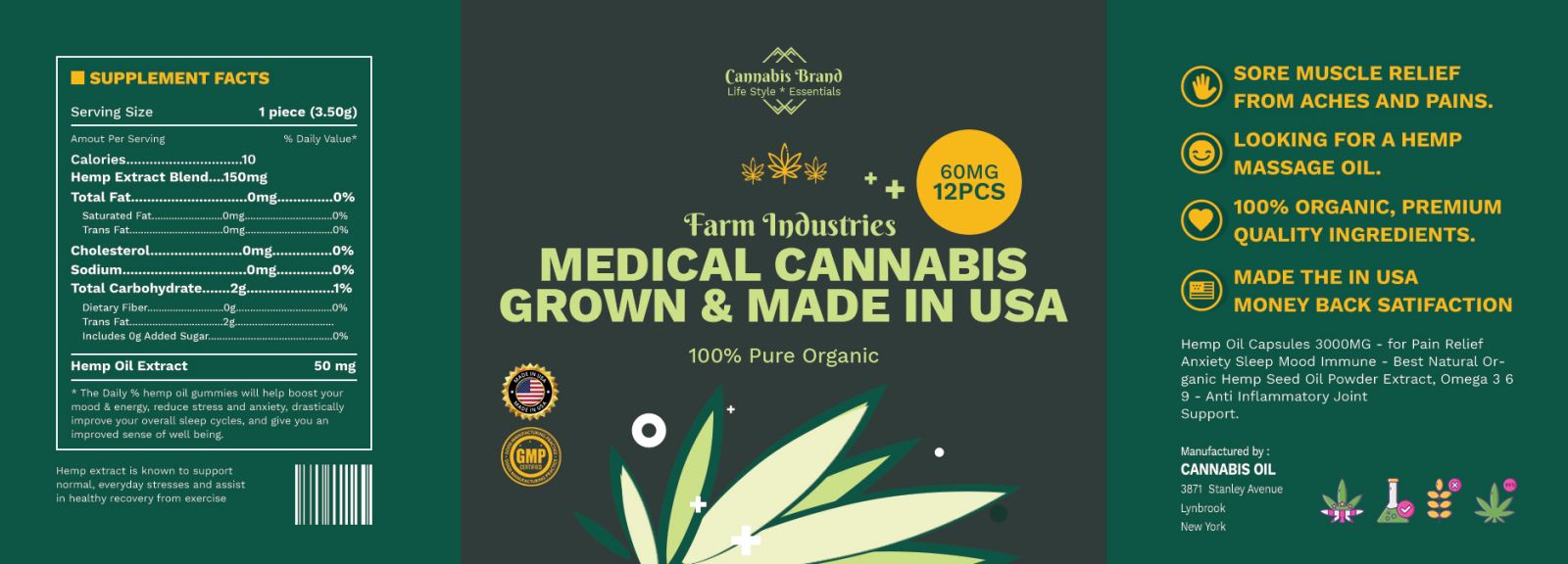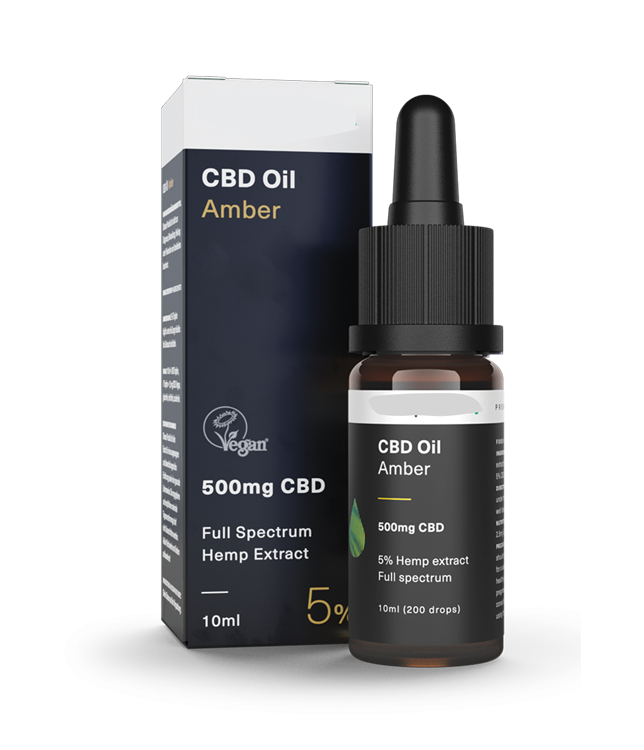If you've ever purchased a product because an appealing label caught your eye or facilitated an emotional reaction, you understand the important part that labels play in successful marketing. As the market continues to expand, it's more important than ever that labels provide original and attractive properties that help the product stand out from the crowd. However, that's not their only function. At the most basic level, labels draw attention to the product, but they must also provide consumers with accurate information concerning ingredients, nutritional value as defined by the U.S. Food and Drug Administration (FDA), dosage, and any medically based warnings that may exist.
As relative newcomers on today's marketplace, guidelines and regulations concerning labels for CBD and hemp-based products can be confusing, and those on the retail side of the industry sometimes feel as if they're trying to hit a moving target when getting their labels just right. Here's what you need to know about creating a compelling label that will appeal to your target customer base that's also compliant with relevant federal and state regulations:
Federal Regulations for Dietary Supplements
All dietary supplements must contain specific information per the USDA. The legal name of the product and the net quantity of the contents of the container must be clearly visible on the front panel of the label. Nutritional information, ingredient lists beginning with the prevailing one and continuing in descending order, and the name of the distributor, packer, or manufacturer must either accompany the name and quantity on the front panel or be placed to its immediate right in a designated information panel.
Federal Regulations for Cosmetic Products
Federal regulations for cosmetic products containing CBD and other cannabis-derived ingredients are similar to those for dietary supplements with a couple of exceptions. The legal name of the product and the net quantity of the contents must appear on the front panel, while the ingredient list and name of the manufacturer, distributor, or packer must be on the information panel to the right. Instead of nutritional information, however, the information panel must also contain directions for safe use of the product as well as any applicable FDA warnings.
Federal regulations do not allow the use of marketing language that may be interpreted by consumers as claims of health or medical benefits. Although CBD products may indeed have a number of therapeutic benefits, the FDA feels that the industry is still too new to have established the safety and effectiveness of CBD to any significant extent. At present, it's best to avoid making health claims of any sort until and unless further research finds that these claims have significant merit.
However, keep in mind that although you cannot legally make specific therapeutic claims, you may be able to use certain adjectives and other descriptors designed to convey a specific message. For instance, although you are not allowed by law to claim that your product containing CBD/lemon balm/melatonin is a cure for a condition such as insomnia, you can use creative hints such as describing the product as a "soothing blend of CDB/lemon balm/melatonin." You can also use color on your label to communicate various moods, such as splashes of yellow for light-heartedness and greens and blues for peace and calm.
Federal Regulations and Design Issues
Federal regulations also cover certain aspects of the label's design. The front panel must be large enough so that the details are displayed prominently enough to be easily readable by the average consumer. Background shades and colors must provide enough contrast with the lettering so that it doesn't interfere with readability, and all letters must be a minimum of one-sixteenth of an inch high. Design elements must not obscure the contents of the label in any way.
State Regulations
Labeling on CBD products must also be in compliance with individual state regulations. These may vary significantly from state to state, so be sure to research regulations in your state prior to designing your label. Your state's department of agriculture is your best resource for this research.
Best Practices for Creating Quality CBD Labels
Ensuring that they're compliant with FDA and state regulations is just part of creating quality labels — you still need to catch the interest of the consumer at the retail outlet level. One of the biggest mistakes is overusing the CBD acronym. Since these products are grouped together on retail shelves, your label doesn't have to loudly announce the presence of that particular ingredient. Focusing on secondary ingredients may be a better approach to reaching your target audience, particularly if those other ingredients offer something unique that the products on the neighboring shelves don't have. For instance, if you might decide to pair CBD with scrumptious Belgian chocolate, artisan honey, or other top-quality ingredients, so make sure that stands out on your label.
You can also highlight other characteristics such as your product being sugar-free, THC-free, vegan, non-GMO, made in the United States, and sourced using sustainable methods. Other strategies for crafting an effective and appealing label include the following:
Strive for brand recognition
Consider hiring a professional graphic designer to create a quality logo that can become synonymous with your brand. This helps consumers identify your products at first glance.
Add a testing seal
Even though current federal regulations don't require that supplements and cosmetic products containing CBD and hemp undergo a testing process, a seal from a third-party lab on your label lends credibility to your brand.
Include educational content
Some consumers still have misconceptions concerning CBD and hemp products, so consider adding language to your label that explains what CBD is and how it's used. This will help establish your brand as an authoritative source and build consumer trust and confidence.
CBD labeling is definitely a lot to keep up with, especially because the industry is so new. Hiring an experienced product labeling attorney as your final step toward putting a new label on your products will provide you with an extra layer of protection and security.
custom_cannabis_labels.gif
If you've ever purchased a product because an appealing label caught your eye or facilitated an emotional reaction, you understand the important part that labels play in successful marketing. As the market continues to expand, it's more important than ever that labels provide original and attractive properties that help the product stand out from the crowd. However, that's not their only function. At the most basic level, labels draw attention to the product, but they must also provide consumers with accurate information concerning ingredients, nutritional value as defined by the U.S. Food and Drug Administration (FDA), dosage, and any medically based warnings that may exist.
As relative newcomers on today's marketplace, guidelines and regulations concerning labels for CBD and hemp-based products can be confusing, and those on the retail side of the industry sometimes feel as if they're trying to hit a moving target when getting their labels just right. Here's what you need to know about creating a compelling label that will appeal to your target customer base that's also compliant with relevant federal and state regulations:
Federal Regulations for Dietary Supplements
All dietary supplements must contain specific information per the USDA. The legal name of the product and the net quantity of the contents of the container must be clearly visible on the front panel of the label. Nutritional information, ingredient lists beginning with the prevailing one and continuing in descending order, and the name of the distributor, packer, or manufacturer must either accompany the name and quantity on the front panel or be placed to its immediate right in a designated information panel.
Federal Regulations for Cosmetic Products
Federal regulations for cosmetic products containing CBD and other cannabis-derived ingredients are similar to those for dietary supplements with a couple of exceptions. The legal name of the product and the net quantity of the contents must appear on the front panel, while the ingredient list and name of the manufacturer, distributor, or packer must be on the information panel to the right. Instead of nutritional information, however, the information panel must also contain directions for safe use of the product as well as any applicable FDA warnings.
Federal regulations do not allow the use of marketing language that may be interpreted by consumers as claims of health or medical benefits. Although CBD products may indeed have a number of therapeutic benefits, the FDA feels that the industry is still too new to have established the safety and effectiveness of CBD to any significant extent. At present, it's best to avoid making health claims of any sort until and unless further research finds that these claims have significant merit.
However, keep in mind that although you cannot legally make specific therapeutic claims, you may be able to use certain adjectives and other descriptors designed to convey a specific message. For instance, although you are not allowed by law to claim that your product containing CBD/lemon balm/melatonin is a cure for a condition such as insomnia, you can use creative hints such as describing the product as a "soothing blend of CDB/lemon balm/melatonin." You can also use color on your label to communicate various moods, such as splashes of yellow for light-heartedness and greens and blues for peace and calm.

Federal Regulations and Design Issues
Federal regulations also cover certain aspects of the label's design. The front panel must be large enough so that the details are displayed prominently enough to be easily readable by the average consumer. Background shades and colors must provide enough contrast with the lettering so that it doesn't interfere with readability, and all letters must be a minimum of one-sixteenth of an inch high. Design elements must not obscure the contents of the label in any way.
State Regulations
Labeling on CBD products must also be in compliance with individual state regulations. These may vary significantly from state to state, so be sure to research regulations in your state prior to designing your label. Your state's department of agriculture is your best resource for this research.

Best Practices for Creating Quality CBD Labels
Ensuring that they're compliant with FDA and state regulations is just part of creating quality labels — you still need to catch the interest of the consumer at the retail outlet level. One of the biggest mistakes is overusing the CBD acronym. Since these products are grouped together on retail shelves, your label doesn't have to loudly announce the presence of that particular ingredient. Focusing on secondary ingredients may be a better approach to reaching your target audience, particularly if those other ingredients offer something unique that the products on the neighboring shelves don't have. For instance, if you might decide to pair CBD with scrumptious Belgian chocolate, artisan honey, or other top-quality ingredients, so make sure that stands out on your label.
You can also highlight other characteristics such as your product being sugar-free, THC-free, vegan, non-GMO, made in the United States, and sourced using sustainable methods. Other strategies for crafting an effective and appealing label include the following:
Strive for brand recognition
Consider hiring a professional graphic designer to create a quality logo that can become synonymous with your brand. This helps consumers identify your products at first glance.
Add a testing seal
Even though current federal regulations don't require that supplements and cosmetic products containing CBD and hemp undergo a testing process, a seal from a third-party lab on your label lends credibility to your brand.
Include educational content
Some consumers still have misconceptions concerning CBD and hemp products, so consider adding language to your label that explains what CBD is and how it's used. This will help establish your brand as an authoritative source and build consumer trust and confidence.
CBD labeling is definitely a lot to keep up with, especially because the industry is so new. Hiring an experienced product labeling attorney as your final step toward putting a new label on your products will provide you with an extra layer of protection and security.